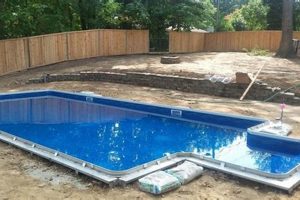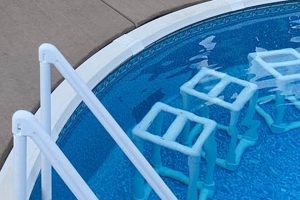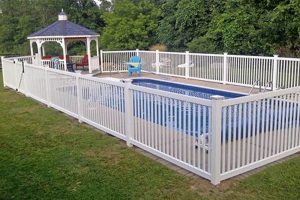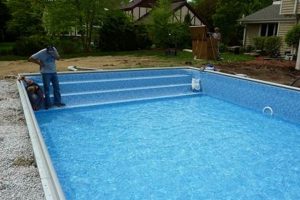A structure designed and constructed by the homeowner to shield a swimming pool’s circulation device from the elements and potential damage is the subject of this discussion. Such protective measures often utilize readily available materials and basic construction techniques. For instance, a simple enclosure built from treated lumber and corrugated plastic sheeting serves as an example.
Implementing protective housings for pool equipment offers several advantages. These include extending the lifespan of the pump motor and associated components by mitigating exposure to rain, sun, and extreme temperatures. Furthermore, such coverings can reduce operational noise levels, enhance overall backyard aesthetics by concealing the equipment, and improve safety by limiting unauthorized access or accidental contact with electrical components. Historically, such enclosures were primarily custom-built due to limited availability of pre-fabricated options tailored to specific pump configurations.
Subsequent sections will delve into the critical factors in planning and building these protective structures, considering aspects like material selection, ventilation requirements, noise reduction strategies, and compliance with local building codes and safety regulations.
Essential Considerations for Pool Pump Protection
Constructing a protective housing for a pool’s circulation system requires careful planning and execution. The following guidelines emphasize critical aspects of the building process, ensuring both effectiveness and safety.
Tip 1: Material Selection: Opt for weather-resistant materials, such as treated lumber, composite decking, or durable plastics. These minimize degradation from moisture, UV exposure, and temperature fluctuations. Untreated wood is generally unsuitable.
Tip 2: Ventilation is Paramount: Adequate airflow is crucial to prevent overheating of the pump motor. Integrate strategically placed vents or louvers into the design, ensuring sufficient cross-ventilation. Insufficient ventilation will shorten the pump’s lifespan.
Tip 3: Noise Reduction Strategies: Incorporate sound-dampening materials, such as acoustic foam or dense rubber mats, to mitigate operational noise. Proper insulation can significantly reduce sound transmission to neighboring properties.
Tip 4: Accessibility for Maintenance: Design the structure with easy access for routine maintenance and repairs. Hinged doors or removable panels facilitate convenient access to the pump and related plumbing. Obstructed access can complicate servicing.
Tip 5: Compliance with Codes: Prior to construction, verify local building codes and regulations pertaining to pool equipment enclosures. Adherence to these codes ensures safety and avoids potential legal complications. Electrical codes are particularly important.
Tip 6: Secure Foundation: Ensure the structure rests on a stable and level foundation. A concrete slab or gravel base provides a solid and durable platform, preventing settling and structural instability. An unstable foundation will compromise the integrity of the structure.
Tip 7: Weatherproofing Details: Pay meticulous attention to weatherproofing joints and seams. Use waterproof sealants and flashing to prevent water intrusion, which can damage the pump and electrical components. Neglecting weatherproofing can lead to premature equipment failure.
These guidelines emphasize the importance of durable materials, ventilation, noise mitigation, accessibility, and code compliance. Implementing these measures will ensure a functional, safe, and aesthetically pleasing enclosure for the pool’s circulation system.
The subsequent sections will address potential challenges and advanced techniques related to this undertaking.
1. Material Durability
The longevity and protective efficacy of a pool circulation system enclosure are directly contingent upon the inherent durability of the materials employed in its construction. The selection of materials lacking resistance to environmental stressors, such as ultraviolet radiation, moisture, and fluctuating temperatures, inevitably results in premature degradation of the protective structure. This degradation compromises the enclosure’s primary function of shielding the pump and associated components from external damage and accelerated wear. For example, using untreated lumber for the frame of the structure invites rot and insect infestation, leading to structural failure within a relatively short timeframe. Similarly, employing thin, non-UV-resistant plastic sheeting for the enclosure walls will result in cracking and disintegration under prolonged sun exposure.
Conversely, the utilization of durable materials, such as pressure-treated lumber, composite decking, or UV-stabilized polymers, ensures the structure’s resilience against these detrimental environmental influences. Pressure-treated lumber resists rot and insect damage, extending the lifespan of the structural frame. Composite decking offers comparable durability with reduced maintenance requirements. UV-stabilized polymers maintain their structural integrity and appearance even after prolonged exposure to sunlight. Furthermore, the initial investment in durable materials often translates to long-term cost savings by minimizing the frequency of repairs and replacements. Failure to prioritize material durability introduces the risk of recurring maintenance expenses and potential damage to the pool circulation system itself.
In summary, the selection of robust and weather-resistant materials constitutes a fundamental aspect of creating an effective and long-lasting protective structure for pool circulation systems. The durability of the materials directly impacts the enclosure’s ability to withstand environmental stressors, protect the equipment, and minimize lifecycle costs. Prioritizing material durability represents a critical decision in ensuring the long-term functionality and value of the protective structure.
2. Adequate Ventilation
A fundamental requirement for any structure shielding a pool’s circulation system is adequate ventilation. The operation of a pool pump motor generates substantial heat. Without sufficient airflow, this heat accumulates within the enclosure, leading to elevated internal temperatures. Elevated temperatures can have detrimental effects on the pump motor, potentially causing premature failure of electrical components, reduced motor efficiency, and decreased overall lifespan. In extreme cases, overheating can even pose a fire hazard. Therefore, incorporating adequate ventilation into the design is not merely an optional consideration but a critical safety and operational necessity.
Effective ventilation strategies for a pool pump enclosure involve creating pathways for air to enter and exit the structure. This can be achieved through various methods, including the installation of vents on opposing sides of the enclosure to promote cross-ventilation. The size and placement of these vents should be carefully calculated to ensure sufficient airflow based on the pump motor’s heat output and the enclosure’s dimensions. Louvered vents offer an additional advantage by providing airflow while also preventing rain or debris from entering the enclosure. In some applications, particularly in warmer climates, the use of a thermostatically controlled fan may be necessary to supplement natural ventilation and maintain optimal operating temperatures. Neglecting ventilation can invalidate equipment warranties and necessitate costly repairs or replacements.
In conclusion, the incorporation of adequate ventilation is paramount in the construction of any pool circulation system enclosure. The absence of proper airflow can result in overheating, reduced equipment lifespan, and potential safety hazards. Designing and implementing effective ventilation strategies, such as incorporating appropriately sized vents or auxiliary fans, is essential for maintaining optimal operating conditions and ensuring the long-term reliability of the pool pump motor. Therefore, ventilation is an integral design consideration, impacting both safety and equipment longevity.
3. Noise Mitigation
The operational noise generated by pool circulation systems often presents a significant concern for homeowners and nearby residents. Pumps, particularly older models or those operating under strain, can produce substantial sound levels. A substantial benefit of constructing a protective enclosure around the equipment is the opportunity to implement noise mitigation strategies. The structure itself acts as a barrier, reducing the transmission of sound waves. However, the effectiveness of this barrier is greatly enhanced by incorporating sound-absorbing materials within its construction. For example, a simple wooden enclosure provides minimal sound reduction, whereas the same enclosure lined with acoustic foam or fiberglass insulation can significantly dampen the noise emanating from the pump.
Various techniques can be employed to mitigate noise within a circulation system enclosure. Lining the interior walls with sound-absorbing materials, as mentioned above, is a primary approach. The strategic placement of these materials, particularly around the pump motor, is crucial. Additionally, ensuring that the pump is mounted on vibration-dampening pads reduces the transmission of vibrations to the enclosure structure, further minimizing noise. Consideration should also be given to the design of ventilation openings, as these can act as pathways for sound to escape. Baffled vents, which incorporate internal barriers to disrupt sound waves, offer a compromise between ventilation and noise reduction. Failing to address noise pollution may lead to strained relationships with neighbors or, in some cases, violations of local noise ordinances.
Effective noise mitigation is an essential component of a well-designed circulation system enclosure. The construction of such a structure provides an ideal opportunity to address this issue proactively. By carefully selecting construction materials, incorporating sound-absorbing elements, and optimizing the enclosure’s design, homeowners can significantly reduce the noise impact of their pool equipment, creating a more peaceful and enjoyable environment for themselves and their neighbors. Ignoring this aspect can result in ongoing disturbance and potential legal ramifications. The value proposition of effective noise mitigation therefore extends beyond mere comfort, contributing to harmonious community relations and compliance with local regulations.
4. Accessibility
The ease with which a pool pump and its related components can be reached for maintenance, repair, and inspection directly influences the long-term usability and cost-effectiveness of a custom-built enclosure. A poorly designed enclosure, despite offering protection from the elements, can impede routine servicing. This can result in delayed maintenance, potentially leading to more significant equipment failures and increased repair expenses. An example is an enclosure constructed with permanently fixed panels, necessitating partial or complete disassembly to access the pump for even minor tasks, such as cleaning the pump basket or inspecting electrical connections.
Conversely, a well-designed enclosure integrates accessibility as a primary design consideration. This can be achieved through features such as hinged doors, removable panels, or strategically placed access points. These elements allow technicians or homeowners to readily reach the pump, plumbing, and electrical components without requiring specialized tools or extensive dismantling. For instance, a hinged door positioned directly in front of the pump motor provides unobstructed access for inspection and repair. Removable panels offer flexibility for accessing components located on the sides or rear of the pump. Furthermore, adequate internal space within the enclosure facilitates movement and maneuverability during maintenance procedures. Adherence to recommended clearances around the equipment, as specified by the manufacturer, is also crucial.
In summary, accessibility is a crucial yet frequently overlooked aspect of circulation system enclosures. Prioritizing this design element not only simplifies routine maintenance but also minimizes the potential for delays and complications during repairs. The long-term benefits of incorporating accessibility into the design outweigh the initial effort required, ensuring the continued efficient and cost-effective operation of the pool circulation system. Neglecting accessibility can transform a protective enclosure into an impediment, negating its intended purpose.
5. Code Adherence
Compliance with local building codes and electrical regulations is a paramount consideration when constructing a housing for a pool circulation system. Ignoring these codes can lead to significant safety hazards, legal repercussions, and the potential for costly modifications to rectify non-compliant installations. The following outlines key facets of code adherence relevant to such projects.
- Electrical Safety Standards
Local electrical codes typically mandate specific requirements for wiring, grounding, and the installation of electrical components within the vicinity of a swimming pool. These regulations are designed to minimize the risk of electric shock hazards. For instance, wiring must be protected within conduits, and ground fault circuit interrupters (GFCIs) are often required for all electrical outlets serving the pool equipment. Failure to adhere to these standards can result in electrocution and significant liability.
- Setback Requirements and Zoning Regulations
Many municipalities enforce setback requirements that dictate the minimum distance a structure must be from property lines, easements, and other structures. Zoning regulations may also restrict the size, height, and appearance of accessory buildings. Non-compliance with these requirements can result in fines, legal action, and the forced removal or alteration of the enclosure.
- Ventilation and Enclosure Material Specifications
Building codes often specify minimum ventilation requirements to prevent the accumulation of flammable vapors or excessive heat within an enclosure. Additionally, some codes may regulate the types of materials that can be used for construction, restricting the use of flammable or easily degradable materials. These regulations are designed to minimize fire risks and ensure the structural integrity of the enclosure.
- Permitting and Inspection Processes
Most jurisdictions require a building permit prior to the construction of a structure exceeding a certain size or complexity. The permitting process involves submitting detailed plans for review and undergoing inspections at various stages of construction to ensure compliance with applicable codes. Failure to obtain the necessary permits and inspections can result in fines, stop-work orders, and the potential for forced demolition of the non-compliant structure.
Adherence to building and electrical codes is not merely a procedural formality but a critical component of ensuring the safety, legality, and longevity of a pool circulation system enclosure. Compliance protects the homeowner, occupants, and neighbors from potential hazards and mitigates the risk of legal and financial liabilities. Therefore, thorough research of local regulations and diligent adherence to code requirements are essential prerequisites for any such project.
6. Structural Stability
Structural stability is a primary engineering consideration in the construction of any enclosure, including those intended to house pool circulation systems. The enclosure must withstand various environmental loads and stresses to ensure the long-term protection of the equipment and the safety of individuals in the vicinity. Without adequate structural integrity, the enclosure may fail, exposing the pump and related components to damage from weather, impact, or vandalism.
- Foundation Integrity
The foundation serves as the bedrock upon which the entire structure rests. A structurally deficient foundation will compromise the stability of the enclosure, leading to settling, cracking, and potential collapse. Proper soil compaction, adequate load-bearing capacity, and resistance to erosion are essential characteristics of a stable foundation. For instance, an enclosure built on uncompacted soil may gradually sink, causing structural stress and misalignment. Similarly, a foundation susceptible to water damage may erode over time, undermining the enclosure’s support.
- Material Load Capacity
The materials used in the construction of the enclosure must possess sufficient strength and rigidity to withstand the anticipated loads. These loads include the weight of the enclosure itself, as well as external forces such as wind, snow, and impact from objects. Selecting materials with inadequate load-bearing capacity can lead to deflection, cracking, and eventual failure of the structure. For example, using thin or low-grade lumber for the framing of the enclosure may result in warping or collapse under heavy snow loads.
- Joint and Connection Strength
The connections between structural members are critical points of vulnerability. Weak or improperly constructed joints can compromise the overall stability of the enclosure, even if the individual materials possess sufficient strength. Connections must be designed to resist shear, tension, and compression forces. Examples of structurally sound connections include properly fastened screws, bolts, or welded joints. In contrast, connections relying solely on adhesives or insufficient fasteners may fail under stress, leading to structural instability.
- Resistance to Environmental Loads
A structurally stable enclosure must be capable of withstanding the forces imposed by environmental factors such as wind, rain, snow, and temperature fluctuations. Wind loads can exert significant pressure on the enclosure, potentially causing it to overturn or collapse. Snow accumulation can add substantial weight, placing stress on the roof and supporting structure. Repeated expansion and contraction due to temperature changes can weaken materials and connections over time. The design and construction of the enclosure should account for these environmental factors to ensure long-term stability. For example, a roof with a steep pitch is more resistant to snow accumulation than a flat roof. Similarly, selecting materials that are resistant to moisture and UV degradation will enhance the enclosure’s durability in harsh climates.
The factors discussed are intrinsically linked to the successful creation of a protective housing for pool circulation equipment. By addressing these considerations during the design and construction phases, the risk of structural failure can be minimized, ensuring the long-term protection of the equipment and the safety of the surrounding environment.
7. Weather Protection
The primary function of a self-constructed enclosure for pool circulation equipment is the provision of weather protection. The detrimental effects of prolonged exposure to environmental elements, such as direct sunlight, precipitation, and extreme temperature fluctuations, accelerate the degradation of the pump motor and associated components. Direct sunlight can cause plastic housings to become brittle and crack, while rainwater can infiltrate electrical connections, leading to corrosion and electrical malfunctions. Freezing temperatures can cause water within the pump to expand, potentially cracking the pump housing or damaging internal components. Consequently, adequate weather protection is not merely a cosmetic consideration but a critical factor in extending the operational lifespan of the equipment and minimizing maintenance costs. A structure designed and built without proper consideration for these factors fails to fulfill its intended purpose.
The implementation of effective weather protection strategies involves several key design considerations. Overhanging eaves or a sloped roof can deflect rainwater away from the enclosure. Waterproofing sealants and flashing should be applied to all joints and seams to prevent water intrusion. Materials resistant to ultraviolet radiation should be selected for the exterior cladding. Adequate ventilation must be maintained to prevent the buildup of condensation within the enclosure, which can also contribute to corrosion. An elevated base or plinth can further protect the equipment from ground moisture. For example, a simple, box-shaped enclosure constructed from untreated wood and lacking proper weatherproofing details offers minimal protection against the elements and is likely to deteriorate rapidly, exposing the equipment to the very conditions it was intended to shield against. Conversely, a well-designed and constructed enclosure incorporating these weather protection features can provide years of reliable service, safeguarding the pool circulation system from environmental damage.
In conclusion, weather protection represents an indispensable element of a functional pool equipment enclosure. Its effectiveness directly dictates the longevity and reliability of the protected equipment. Challenges often arise from underestimating the severity of local weather conditions or from utilizing inappropriate materials and construction techniques. Prioritizing robust weather protection measures is essential to realize the full benefits of such structures, ensuring that the investment in a custom-built enclosure translates into tangible cost savings and enhanced equipment performance over time.
Frequently Asked Questions
The following addresses common inquiries regarding the design, construction, and utility of structures designed to shield pool circulation systems.
Question 1: Is a permit required for construction of a protective housing for pool equipment?
Permitting requirements vary by jurisdiction. It is imperative to consult local building codes and regulations prior to commencing construction. Structures exceeding a specified size or altering existing electrical systems typically necessitate a permit. Failure to obtain necessary permits can result in fines and mandated removal of the unapproved structure.
Question 2: What is the optimal placement for ventilation openings in an equipment enclosure?
Ventilation openings should be strategically positioned to promote cross-ventilation. This typically involves placing vents on opposing sides of the enclosure to facilitate airflow. The size and number of vents should be determined based on the pump motor’s heat output and the overall dimensions of the enclosure. Obstructed airflow can lead to overheating and premature motor failure.
Question 3: What materials are best suited for reducing noise transmission from the pump motor?
Sound-absorbing materials, such as acoustic foam or fiberglass insulation, are effective at mitigating noise transmission. These materials should be applied to the interior walls of the enclosure, particularly around the pump motor. Vibration-dampening pads placed beneath the pump can further reduce noise levels by minimizing the transmission of vibrations to the structure.
Question 4: How can accessibility for maintenance be ensured?
Enclosures should be designed with readily accessible access points for routine maintenance and repairs. This can be achieved through the incorporation of hinged doors or removable panels that provide unobstructed access to the pump, plumbing, and electrical components. Confined spaces hinder maintenance and can increase service costs.
Question 5: What steps should be taken to protect the equipment from water damage?
Waterproofing is crucial to prevent damage from rainwater and moisture. Sealants and flashing should be applied to all joints and seams to prevent water intrusion. An elevated base or plinth can further protect the equipment from ground moisture. Furthermore, ensure adequate ventilation to minimize condensation buildup within the enclosure.
Question 6: What are the potential consequences of ignoring building codes and regulations?
Non-compliance with building codes and regulations can result in various adverse consequences, including fines, stop-work orders, mandated removal of the non-compliant structure, and potential legal liability in the event of accidents or injuries. Moreover, non-compliant electrical installations pose a significant safety risk.
These considerations underscore the importance of meticulous planning, adherence to relevant regulations, and the use of appropriate materials and construction techniques when building an equipment enclosure. Safety and long-term functionality are paramount.
The following section will address advanced construction techniques and material options.
DIY Pool Pump Cover
The preceding discourse has thoroughly examined the construction of protective housings for pool circulation equipment. From material selection and ventilation strategies to code adherence and noise mitigation techniques, the discussion has underscored the critical factors influencing the efficacy and longevity of a diy pool pump cover. The importance of considering structural stability and weather protection has been emphasized, along with the necessity for accessibility in facilitating routine maintenance and repairs.
Constructing a diy pool pump cover presents a viable method for safeguarding valuable pool equipment, minimizing operational noise, and enhancing overall property aesthetics. However, prospective builders must recognize that such undertakings necessitate meticulous planning, diligent execution, and a thorough understanding of applicable building codes and safety regulations. Prioritizing safety, compliance, and durable construction practices will ensure that the final product provides enduring protection and contributes positively to the property’s value and environmental harmony.







